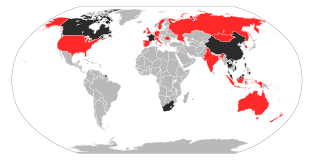
A quarantine is a restriction on the movement of people, animals and goods which is intended to prevent the spread of disease or pests. It is often used in connection to disease and illness, preventing the movement of those who may have been exposed to a communicable disease, yet do not have a confirmed medical diagnosis. It is distinct from medical isolation, in which those confirmed to be infected with a communicable disease are isolated from the healthy population. Quarantine considerations are often one aspect of border control.

Severe acute respiratory syndrome (SARS) is a viral respiratory disease of zoonotic origin caused by the virus SARS-CoV-1, the first identified strain of the SARS-related coronavirus. The first known cases occurred in November 2002, and the syndrome caused the 2002–2004 SARS outbreak. In the 2010s, Chinese scientists traced the virus through the intermediary of Asian palm civets to cave-dwelling horseshoe bats in Xiyang Yi Ethnic Township, Yunnan.

The 2002–2004 outbreak of SARS, caused by severe acute respiratory syndrome coronavirus, infected over 8,000 people from 30 countries and territories, and resulted in at least 774 deaths worldwide.

The National Institute for Public Health and the Environment is a Dutch research institute that is an independent agency of the Ministry of Health, Welfare and Sport.

A superspreading event (SSEV) is an event in which an infectious disease is spread much more than usual, while an unusually contagious organism infected with a disease is known as a superspreader. In the context of a human-borne illness, a superspreader is an individual who is more likely to infect others, compared with a typical infected person. Such superspreaders are of particular concern in epidemiology.

The global COVID-19 pandemic arrived in Europe with its first confirmed case in Bordeaux, France, on 24 January 2020, and subsequently spread widely across the continent. By 17 March 2020, every country in Europe had confirmed a case, and all have reported at least one death, with the exception of Vatican City.

COVID-19 testing involves analyzing samples to assess the current or past presence of SARS-CoV-2. The two main types of tests detect either the presence of the virus or antibodies produced in response to infection. Molecular tests for viral presence through its molecular components are used to diagnose individual cases and to allow public health authorities to trace and contain outbreaks. Antibody tests instead show whether someone once had the disease. They are less useful for diagnosing current infections because antibodies may not develop for weeks after infection. It is used to assess disease prevalence, which aids the estimation of the infection fatality rate.

The COVID-19 pandemic in the Netherlands has resulted in 8,623,210 confirmed cases of COVID-19 and 22,986 deaths.
The COVID-19 pandemic in Norway has resulted in 1,494,968 confirmed cases of COVID-19 and 5,732 deaths.

The COVID-19 pandemic in Liechtenstein was a part of the ongoing worldwide pandemic of coronavirus disease 2019 caused by severe acute respiratory syndrome coronavirus 2. The virus was confirmed to have reached Liechtenstein in early March 2020. With a total population of 38,896 and 54 confirmed deaths, the country has one of the highest rate of confirmed deaths per capita in the world.

The COVID-19 pandemic in Egypt was a part of the worldwide pandemic of coronavirus disease 2019 caused by severe acute respiratory syndrome coronavirus 2. The virus was confirmed to have reached Egypt on 14 February 2020.

The COVID-19 pandemic was confirmed to have spread to Georgia when its first case was confirmed in Tbilisi on 26 February 2020.

The COVID-19 pandemic in Slovenia was a part of the pandemic of coronavirus disease 2019 caused by severe acute respiratory syndrome coronavirus 2. The first slovenian citizen to be infected was resulted positive on 3 March 2020, the infection was contracted during an internal flight in Italy. The first case in Slovenia was confirmed a day later; it was an imported case transmitted by a tourist traveling from Morocco via Italy. Italy was the center of the SARS-CoV-2 in Europe at the time.
The COVID-19 pandemic in Malta was a part of the worldwide pandemic of coronavirus disease 2019 caused by severe acute respiratory syndrome coronavirus 2. The first case of the disease in Malta was an Italian 12-year-old girl on 7 March 2020. The girl and her family were in isolation, as required by those following the Maltese health authority's guidelines who were in Italy or other highly infected countries. Later, both her parents were found positive as well.

The COVID-19 pandemic in Panama was a part of the worldwide pandemic of the coronavirus disease caused by severe acute respiratory syndrome coronavirus 2. The virus was confirmed to have spread to Panama on 9 March 2020. One of the dead was a 64-year-old male, who also had diabetes and pneumonia. Of those infected, 83 were hospitalized. The infected individuals belonged to the 29-59 age group and had each recently travelled abroad. A 13-year-old girl died of COVID-19 on 23 March 2020.

The COVID-19 pandemic in Kyrgyzstan was a part of the worldwide pandemic of coronavirus disease 2019 caused by severe acute respiratory syndrome coronavirus 2. The virus was confirmed to have reached Kyrgyzstan in March 2020.
The COVID-19 pandemic in Saba is part of the ongoing global viral pandemic of coronavirus disease 2019 (COVID-19), which was confirmed to have reached the Dutch Caribbean island of Saba on April 12, 2020. At the beginning of the pandemic, the island had a population of just over 1,900 people. As of 12 May, all cases were reported to have recovered. On 1 August, two new cases were imported which resolved on 9 September.

A coronavirus breathalyzer is a diagnostic medical device enabling the user to test with 90% or greater accuracy the presence of severe acute respiratory syndrome coronavirus 2 in an exhaled breath. As of the first half of 2020, the idea of a practical coronavirus breathalyzer was concomitantly developed by unrelated research groups in Australia, Canada, Finland, Germany, Indonesia, Israel, Netherlands, Poland, Singapore, United Kingdom and USA.

In the European Netherlands, a Municipal Health Service is a decentralised public health organisation. Legally, the responsibility for the provision of this service lies with the municipalities. However, in practice, the municipalities work together to provide this service at a regional level, resulting in twenty-five "GGD regions". The borders of the GGD regions largely correspond to the borders of the safety regions.
The 2022–2023 mpox outbreak in the Netherlands is an ongoing global outbreak which has also spread in the Netherlands. The RIVM declared the disease an A-disease which makes it mandatory to report suspected cases to the GGD. The first human case of mpox in the Netherlands has been identified at the 21 May 2022. The outbreak does have a noticeable impact at the society, especially with people spreading misinformation related to the virus. The ongoing COVID-19 pandemic in the Netherlands has increased the fear among the community for a new pandemic like mpox.
















